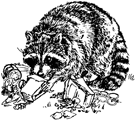Eastern Wildlife Damage Control Conferences
Date of this Version
February 1991
Document Type
Article
Abstract
In May 1990, the mid-Atlantic raccoon (Procyon lotor) rabies epizootic crossed New York State's southern border. By the end of the year, 84 rabid raccoons had been identified from a 400-km "front" in the State's southern tier of counties. By about mid-February 1991, the number of confirmed rabid raccoons increased to 134. Major metropolitan areas are threatened and predictions for the future indicate a pressing need for information and services by various government agencies. High-risk areas currently are park campgrounds, but will be extended as the outbreak progresses to include urban parks and those residential communities having large raccoon populations. Well designed, comprehensive management strategies are needed to reduce human and domestic animal contacts with raccoons during the outbreak. Although many interventions are available, the purpose of this study is to develop methods that will lessen raccoon activity in and around park areas with intense patron use and large raccoon populations. The objective is to reduce raccoon food resources through improved solid-waste storage/removal, and to educate park patrons not to feed raccoons directly or indirectly. Observation and recording of activity patterns and behavior of raccoons and/or humans at study sites is conducted primarily by remote-controlled, low-light videography. We learned that some raccoons easily climb, open lids, and enter some designs of garbage containers, where they may remain for several hours. Raccoons and other wildlife (e.g., skunks [Mephitis mephitis] ) also feed upon spilled garbage and drainage from the garbage containers. Wildlife feeding activity at garbage containers has been observed to partially overlap with the daily activity period of park patrons. We are continuing to investigate the problems and remedial interventions of garbage container design, raccoon and human behavior, and implications for rabies risk reduction.


